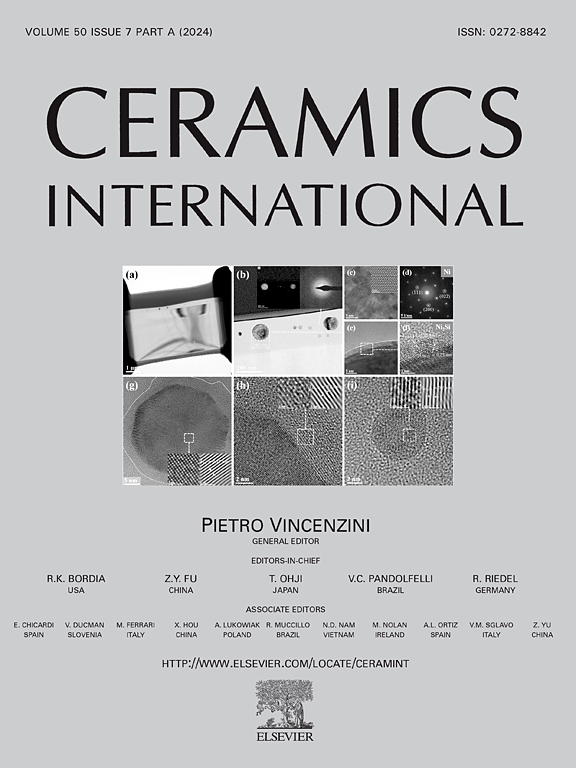类似棉花的自支撑中空SiO2纳米粒子基减反射涂层:设计、制造和优化光学机械性能
IF 5.6
2区 材料科学
Q1 MATERIALS SCIENCE, CERAMICS
引用次数: 0
摘要
开发高性能的光伏玻璃增透涂层是光伏领域的重要要求。本文以水热法合成的多孔ZnS纳米粒子为模板,采用溶胶-凝胶法结合化学蚀刻技术制备了一种内部具有自支撑结构的棉花状中空SiO2纳米AR涂层。随后,以酸性SiO2溶胶为粘合剂制备了酸碱复合自支撑空心SiO2 AR涂层。对复合AR涂层中空心SiO2纳米颗粒的最佳配比进行理论分析,指导后续的实验设计。复合涂层在503 nm处的透光率为97.19%,在380 ~ 800 nm范围内的平均透光率为95.45%,比裸玻璃高出5.40%。复合AR涂层铅笔硬度达到6H,放置90天后透光率基本保持不变,表现出优异的力学性能和耐候性。本工作为设计和制备具有高透光率和机械稳定性的AR涂层提供了理论指导和技术支持,对高性能PV减反射涂层具有重要意义。本文章由计算机程序翻译,如有差异,请以英文原文为准。
Cotton-like self-supporting hollow SiO2 nanoparticle-based antireflection coatings: Design, fabrication, and optimized optical-mechanical properties
Developing high-performance antireflection (AR) coatings for photovoltaic (PV) glass is a significant requirement in the field of PV. In this paper, a cotton-like hollow SiO2 nanoparticle AR coating with self-supporting structure inside was prepared through the sol-gel method combined with chemical etching technique, using porous ZnS nanoparticles synthesized via the hydrothermal method as templates. An acid-base composite self-supporting hollow SiO2 AR coating was subsequently prepared by adding acidic SiO2 sol as adhesive. Theoretical analysis was conducted on the optimal proportion of hollow SiO2 nanoparticles in the composite AR coating to guide subsequent experimental design. The obtained composite coating exhibited a high perk transmittance of 97.19 % at 503 nm and an average transmittance of 95.45 % in the range of 380–800 nm, which is 5.40 % higher than that of bare glass. The pencil hardness of the composite AR coating reached 6H, and the transmittance remained almost unchanged after being left for 90 days, demonstrating excellent mechanical properties and weather resistance. This work provides theoretical guidance and technical support for designing and preparing AR coating with high transmittance and mechanical stability, which is of great importance for high-performance PV antireflective coating.
求助全文
通过发布文献求助,成功后即可免费获取论文全文。
去求助
来源期刊

Ceramics International
工程技术-材料科学:硅酸盐
CiteScore
9.40
自引率
15.40%
发文量
4558
审稿时长
25 days
期刊介绍:
Ceramics International covers the science of advanced ceramic materials. The journal encourages contributions that demonstrate how an understanding of the basic chemical and physical phenomena may direct materials design and stimulate ideas for new or improved processing techniques, in order to obtain materials with desired structural features and properties.
Ceramics International covers oxide and non-oxide ceramics, functional glasses, glass ceramics, amorphous inorganic non-metallic materials (and their combinations with metal and organic materials), in the form of particulates, dense or porous bodies, thin/thick films and laminated, graded and composite structures. Process related topics such as ceramic-ceramic joints or joining ceramics with dissimilar materials, as well as surface finishing and conditioning are also covered. Besides traditional processing techniques, manufacturing routes of interest include innovative procedures benefiting from externally applied stresses, electromagnetic fields and energetic beams, as well as top-down and self-assembly nanotechnology approaches. In addition, the journal welcomes submissions on bio-inspired and bio-enabled materials designs, experimentally validated multi scale modelling and simulation for materials design, and the use of the most advanced chemical and physical characterization techniques of structure, properties and behaviour.
Technologically relevant low-dimensional systems are a particular focus of Ceramics International. These include 0, 1 and 2-D nanomaterials (also covering CNTs, graphene and related materials, and diamond-like carbons), their nanocomposites, as well as nano-hybrids and hierarchical multifunctional nanostructures that might integrate molecular, biological and electronic components.
 求助内容:
求助内容: 应助结果提醒方式:
应助结果提醒方式:


